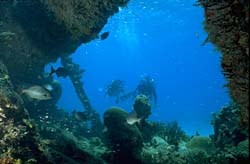Last updated: September 28, 2017
Article
Windjammer Shipwreck

Photo by and courtesy of National Park Service Submerged Resources Center
The Avanti sank on Jnauary 22, 1907 as it was transporting lumber from Pensacola to Montevideo, Uruguay. The details of the sinking of the ship are unknown. There are no historical documents on the event. The ship is 261 feet long by 39 feet wide with three masts, two decks, and a cement ballast. The Avanti is in excellent condition as a result of iron's resistance to corrosion. There are two main wreckage field. The bow section is oriented east-west and the stern section is aligned north-south.
The Avanti, located within Dry Tortugas National Park, rests at a depth of 22 ft. some 1,100 yards southwest of Loggerhead Key. A laminated trail guide is available for use by divers. Fish and marine fauna are highly visible at the wreck; after the vessel was discovered it was used for biological research before it was examined by underwater archeologists.
Florida's Shipwrecks: 300 Years of Maritime History features a Teaching with Historic Places online lesson plan, The Spanish Treasure Fleets of 1715 and 1733: Disasters Strike at Sea. This lesson plan has been produced by the National Park Service's Teaching with Historic Places program, which offers a series of online classroom-ready lesson plans on registered historic places. To learn more, visit the Teaching with Historic Places home page.
